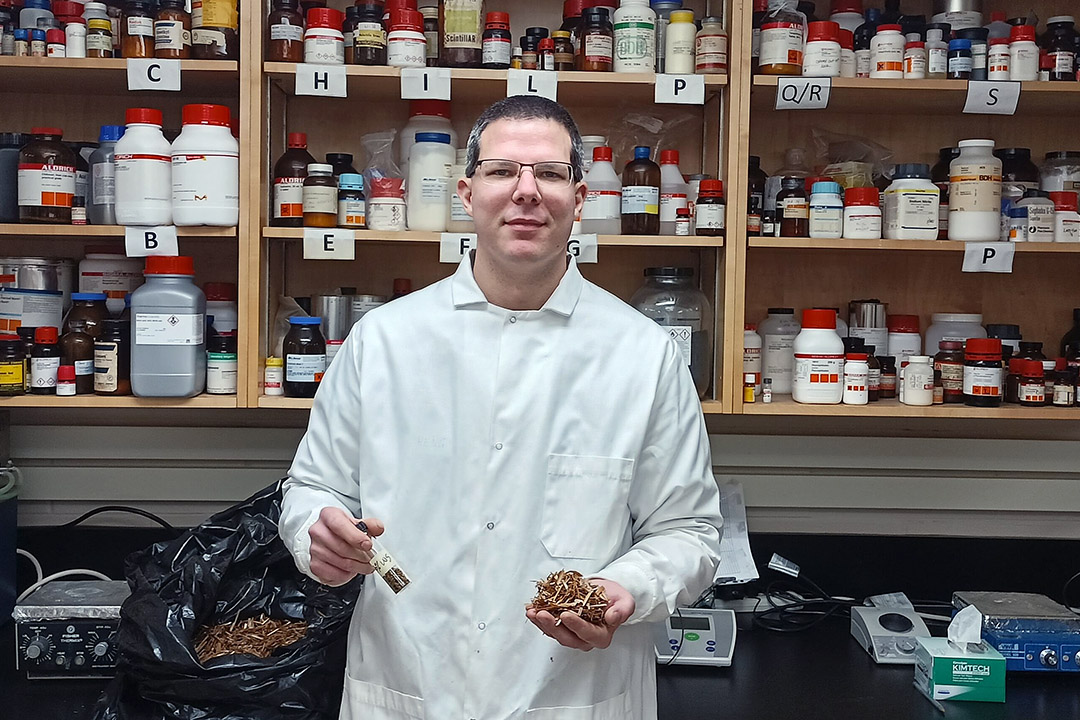
Agro-waste could be the solution to a cleaner water supply in Sask., says USask researcher
Securing a safe water supply for Earth’s growing population is a global goal that is reflected in the long-term sustainability plans of almost every nation. Creatively solving this problem is another matter altogether. University of Saskatchewan (USask) graduate student Bernd Steiger is using chemistry expertise and Saskatchewan-based waste to soak up contaminants in fresh water reserves.
By BROOKE KLEIBOER“This province can be considered the breadbasket of Canada with its large agricultural sector,” said Steiger. “Agro-waste [such as the inedible part of a plant, for example] is a low-value by-product of agriculture, and turning this waste material into specialty adsorbents can aide in generating additional wealth for the Sask. agro-economy, while also serving to address water security and sustainability goals.”
Steiger’s work uses several principles of what is referred to as ‘green chemistry’ - a type of chemistry that avoids a need for conventional chemical or energy inputs. Dr. Lee Wilson (PhD), professor in the Department of Chemistry in the USask College of Arts and Science, has been supervising Steiger’s research as he works to complete his doctoral degree.
“Our question was whether we could use locally available biomass from Saskatchewan such as straw and oat hulls as platform materials to design bioadsorbent materials to address water security issues for Saskatchewan,” said Wilson.
Steiger’s work has focused on using these typically non-consumable agricultural byproducts like wheat straw, coffee grounds and oat hulls as the basis for new adsorbent materials. Adsorbent materials allow a dissolved substance to ‘stick’ to its surface – as opposed to absorbent materials, which allow a substance to permeate it entirely.
The idea is that the resulting adsorbent materials can be placed in aquatic environments that have been contaminated with substances, such as lead, and can draw these contaminants out of the water supply.
In the experiment, the agro-waste base materials were treated and combined with other materials to create new adsorbent products called composites and were tested in a simulated wastewater environment that contained lead or another type of pollutant. Some of the composites contained higher levels of agro-waste than others, and Steiger notes that the results of the experiment were surprising.
“In general, composites with higher content of agro-waste outperformed those with lower agro-waste content,” said Steiger. “The low energy and materials input for our composite design approach demonstrates the unique uses that agro-waste systems can have for sustainability.”
“Through our green chemistry strategy, we have been able to add value to low-cost biomass to address lead contamination in drinking water,” Wilson added. “The resulting adsorbents show promising potential."
Steiger’s work in Wilson’s lab has been documented in the academic journals Frontiers in Water and Industrial Crops and Products in published articles in 2022 and 2023.
“Building on the published work, an investigation is underway of the mechanical properties and stresses [on the material] related to transport, storage, and water treatment applications,” said Steiger. “This will contribute to bringing this technology to industry.”
Further experiments will also test how further physical or chemical modifications to any new adsorbent materials may benefit or hinder their usefulness.
USask is ranked number one in Canada in water resources research, an important research area that is classified as a signature area of research at the university. This unique research focus drove Steiger to pursue graduate studies at USask under the supervision of Wilson.
“Making an impact with respect to sustainability and an often underappreciated and taken for granted commodity – clean drinking water – is one of the driving forces for me,” said Steiger.
The research has been supported by the Natural Sciences and Engineering Council of Canada Discovery Grant program, and the USask Global Institute for Water Security/Global Water Futures Capacity Building Competition award program.
This article first ran as part of the 2023 Young Innovators series, an initiative of the USask Research Profile and Impact office in partnership with the Saskatoon StarPhoenix.

